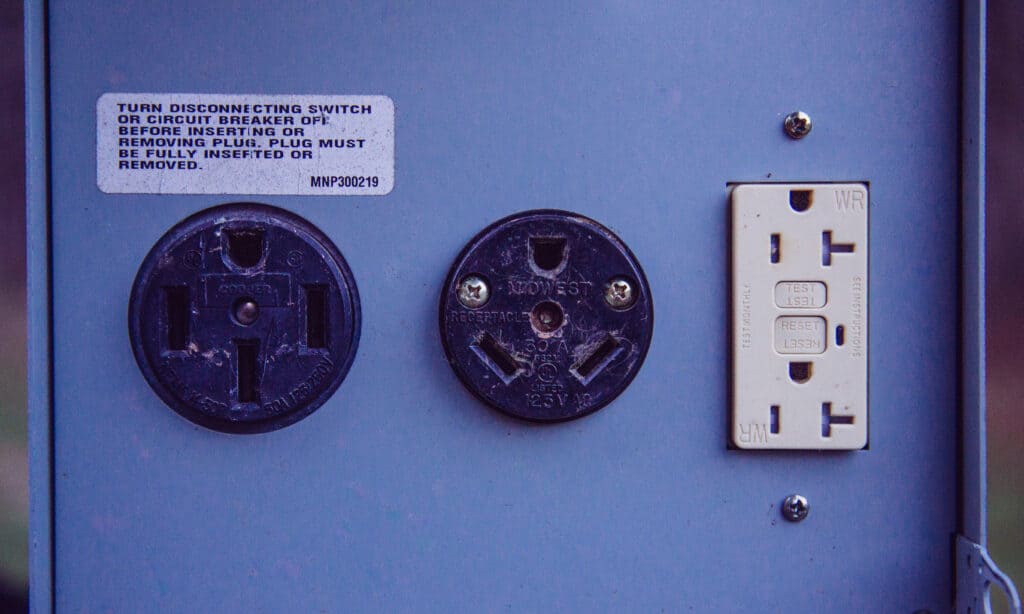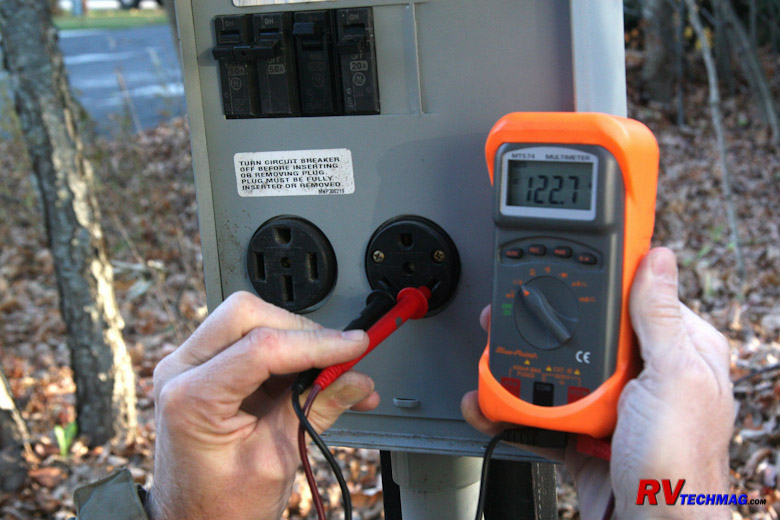Rv Electrical Site Hookup
If an RV park is going to offer any kind of hookup, it’s likely to be this one: shore power. When it comes to an RV electric hookup, it is pretty much as simple as plug and play, but it’s important to power down all your electronics before you do so — just in case the campground’s power source has any faulty wiring that might fry your electronics. You will most likely need to set your RV up to be able to connect to the standard 3-prong household plug you use at home. Since your RV will need at least a 30/50 Amp hookup to power the rig, you'll be limited in what you can run connected to a home's 15/20 Amp electrical outlet.
There is no one 'correct' procedure for connecting to a RV campground's utility hookups. The important thing is to develop a routine and an awareness that prevents contamination, avoids electrical shocks and keeps your feet dry.
- RV Electrical 101 Dennis Gaub. If you own a recreational vehicle that has a 50-amp electrical system and you’ve pulled into a campground where both 50- and 30-amp service are available, please pick the 50-amp service. That request accompanies advice from an expert on RV systems, Jim Finch, KOA’s assistant vice-president/technical services.
- The safest and simplest way to install a home hookup for a recreational vehicle, or RV, is to use a supply pedestal manufactured for the purpose. Supply pedestals are similar to the hookups at most campsites, typically made with one built-in 50-amp outlet, one 30-amp outlet and one or two 20-amp outlets.
Before going through the trouble of backing into a campsite and leveling your rig check the site's electric, water and sewer connections. Check the electric outlet's polarity and voltage, the water's clarity and aroma, and the sewer inlet's opening to be sure it is clear of rocks, cans or debris.
While you are there, rinse off the RV campground water hydrant and spray it with a household disinfectant. You never know what the previous occupant or his dog has left on that hydrant. By the time you have finished backing and leveling your rig, the disinfectant should accomplish its purpose.
Getting the Rig Hooked Up at the Camp Site
Once your rig is in position and leveled, you can go through your hookup routine. First, plug in the electric cord while your hands and the ground are dry. Turn off the electric outlet's breaker switch before inserting or removing the RV's electric plug. This will prevent shocks and avoid damage to the prongs of the plug.
Next, attach a water-pressure regulator to the campground hydrant so it can protect both the drinking-water hose and the RV's plumbing from sudden surges in campground water pressure. A water filter (to remove sediment) is next, followed by the drinking-water hose. Run water through the hose to remove the air then attach the hose to the RV.
By the way, all of the water-hose connections can be made quick and easy with the use of 'quick-connect' fittings on both ends of the water-pressure regulator, water filter and water hose. These handy fittings can be found at RV accessory stores like Camping World and in hardware stores where water hoses are displayed.

How to Hook up an RV - Save Sewer for Last
The sewer hookup is last. Once the hose is connected, double check to be sure the sewer hose is properly secured to both the RV and the sewer inlet. Think seriously about wearing disposable polyethylene gloves when handling the sewer hose. They come in boxes of 100, are inexpensive and can be thrown away after use. Some RVers prefer to use disposable, latex surgical gloves. Even if you wear gloves, it's a good idea to wash your hands with antibacterial soap immediately after handling the sewer hose.

Rv Electrical Site Hookup Guide
The gray water valve may be opened after the sewer hose is connected. The black water valve, however, should remain closed until you are ready to dump. This assures a buildup of liquid in the black water tank. The more liquid in the tank the better the flushing action will be when the valve is opened. A day or so before dumping the black water, close the gray water valve. The captured gray water can be used to rinse the sewer hose after you dump the black water tank.
How to Hook up an RV - Dumping the Holding Tanks
Dumping the holding tanks is pretty straight forward. Black water is dumped first, the valve closed and then the gray water is dumped. The gray water does a good job of rinsing the black water out of the sewer hose. Lifting the RV end of the hose drains the remaining water into the campground's sewer inlet.
After closing both the gray and black water valves, the RV's sewer outlet is capped and the sewer hose stored in the sewer hose compartment. Run the kitchen faucet (using the rig's water pump) to add a couple gallons of water to the gray water tank. Use a two-gallon bucket to pour a few gallons of water through the toilet bowl and into the black water tank. This will prevent any solids from turning into a low-grade cement in the bottom of the tanks. This is also the time to pour in any holding tank additives.

Disconnect in the same order you hooked up; electric first, water next and sewer last.
The drinking-water hose and fixtures should be stored in a compartment separate from the sewer hose and its attachments. Both ends of the drinking-water hose can be connected together to keep moisture in and critters out.
Have you ever noticed an RV sitting in someone's driveway and wondered if you could live in it that way? Well, the answer is yes - sort of! An RV can be hooked up to a home's electrical system, but there are some things you must know.
While it's not suggested to live in an RV outside a home for an extended time (although they can be insulated for longer-term efficiency), short trips will be fine for keeping the lights on during your travels. Let's look at how to hook an RV up to your home and what factors to consider when doing so.
Hooking an RV Up to Your Home's Electrical System
While you can hook your RV up to a home's electrical system, you won't be able to run every appliance or use the electricity 24/7. You will most likely need to set your RV up to be able to connect to the standard 3-prong household plug you use at home. Since your RV will need at least a 30/50 Amp hookup to power the rig, you'll be limited in what you can run connected to a home's 15/20 Amp electrical outlet.
You can hook up an RV up to your home's electrical system in one of two ways: You can ensure what you need is installed when you buy the RV, or you can install a 30/50 Amp hookup at home. If you are visiting a place often, it may be worth it to install a hookup for your RV at the destination.
If you are hooking up to a home's standard outlet, you can do this via an outdoor, all-weather extension cord and 15/20 Amp adapter for your RV's electrical hookups. You want this extension cord to be as short as possible going from your home to your RV to prevent it from overheating.
Follow these steps to hook an RV up to your home's electrical system:
- Before you plug in the extension cord from your home to your RV, ensure all electrical appliances are turned off in your rig.
- Turn off the breakers to your home, too.
- Plug the extension cord into your RV's electrical hookups via an adapter, if necessary.
- Then, reset your home's breakers.
If successful, you're setup properly and ready to use what you need. If not, your breaker will trip before you even head back to your RV.
If the breaker trips, unplug everything and venture inside your RV to ensure all appliances are in fact off, and nothing is plugged in using power anywhere in your rig. Try the above steps again.
Rv Electrical Site Hookup Sites
If these steps still don't work, refer to your RV's manual, contact the manufacturer, or give the dealership a call to talk through the issue.

Installing Rv Hookups At Home
Limitations to Hooking an RV Up to Your Home's Electrical System
Unless you set up a fully operational RV pad at home, you will not be able to use 30/50 Amp setup and will not be able to use everything powered in your rig. To operate within safe parameters, you will only be able to use one appliance at a time in most cases. If you use more than one at a time, you'll trip your home's breakers.
The following RV appliances are electric hogs, so be cautious when running them for long periods of time or trying to run them with other appliances at the same time:
- Air conditioning
- Heater
- Hairdryer
- Microwave
- Toaster
- Toaster oven
Appliances like TV, DVD players, laptops, and your refrigerator can be used at the same time without overloading even a 15/20 Amp connection in most cases. If you notice flickering lights or something turns off on its own, chances are you've overloaded the electrical connection between your RV and home.
Pro Tip: If you're parked in front of your house or someone you know, consider using their appliances rather than running yours whenever possible to conserve energy and prevent overloading the electrical system you're hooked up to for the stay.
When it comes to hooking an RV up to your home's electrical system, proceed with caution. You can damage both your RV and home's electrical system if you plug in and expect everything to work like normal. You need to take your time, understand how your RV works, how your home works, and then get everything hooked up properly.
Rv Electric Hook Up
If you're not sure if you should hook up even the smallest of RVs in your driveway, consult forums, dealerships, and others in the RVing community to make sure you're good to go. Otherwise, you may cause damage that'll cost you time and money to repair properly.